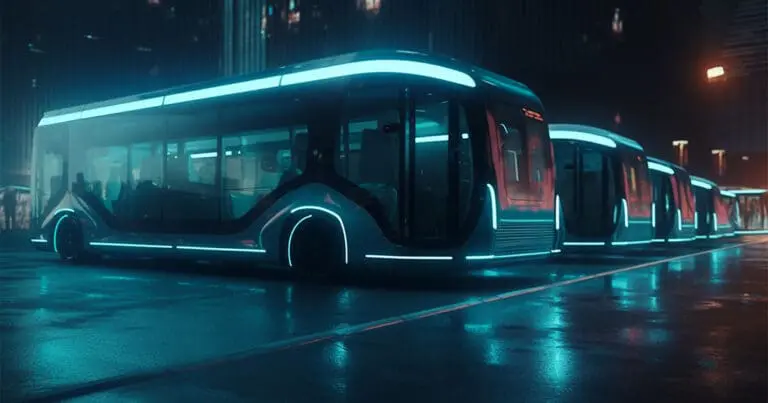How Technology is Shaping the Future of Public Transportation

Public transportation systems globally are on the brink of a monumental shift, propelled by swift technological progress.
With cities expanding at an unprecedented rate, the infusion of cutting-edge technologies into public transport systems is key to improving their efficiency, sustainability, and the overall experience for riders.
Grasping the contributions of experts steering these innovations sheds light on the profound influence technology will have on our everyday travel.
Technological innovations transforming public transportation
Technological innovations transforming public transportation include electric and autonomous vehicles, advanced traffic management systems (ATMS), mobility as a service (MaaS), and big data and AI route optimization.
Electric and autonomous vehicles
The widespread implementation of electric buses across urban landscapes marks a significant leap toward sustainability in public transit.
These vehicles offer a cleaner, quieter alternative to their diesel counterparts and play a crucial role in reducing greenhouse gas emissions, a vital step in combating urban air pollution.
Likewise, the advancement of autonomous vehicle technology is set to refine the safety and reliability of public transportation, leading to a possible future where transit systems are more efficient and safer for all users.
Advanced traffic management systems (ATMS)
Advanced Traffic Management Systems (ATMS) employ sophisticated technology to optimize traffic flow and minimize congestion.
Cities such as Singapore and Stockholm have successfully implemented these systems, demonstrating notable reductions in traffic delays and enhancing the overall efficiency of their transportation networks.
These achievements underscore the potential of ATMS to transform urban mobility, making it smoother and more sustainable for communities worldwide.
Mobility as a service (MaaS)
Mobility as a Service (MaaS) integrates various forms of public and private transportation into a single, accessible on-demand service.
MaaS platforms enhance urban mobility by offering customized travel solutions that can dynamically respond to user needs, significantly improving user convenience and system efficiency.
By leveraging big data and advanced analytics, MaaS facilitates a seamless travel experience, potentially transforming how cities conceptualize and implement transportation strategies.
Big data and AI in route optimization
Leveraging big data analytics and artificial intelligence in public transportation allows for more effective route planning and real-time operational decisions.
AI applications in systems like driverless public transportation optimize routes based on current traffic conditions and passenger demands, enhancing the overall public transit experience.
This optimization leads to reduced wait times, more direct routes, and a significant increase in passenger satisfaction.
Key professionals driving tech advancements in public transportation
Key professionals driving tech advancements in public transportation include transportation planners, data scientists and analysts, software engineers and developers, electrical and mechanical engineers, urban innovators and policy makers, and AI specialists.
Transportation planners
Transportation planners play a pivotal role in orchestrating sustainable and efficient transportation strategies that accommodate the burgeoning demands of modern cities.
Possessing degrees in urban planning or civil engineering, these professionals employ advanced simulation software to foresee future transportation needs and craft innovative solutions.
Their expertise is essential in ensuring that public transportation systems evolve to meet environmental goals and enhance commuter experiences.
Data scientists and analysts
Data scientists and analysts harness the power of statistical analysis and predictive modeling to enhance public transportation systems significantly.
Through their work with AI, they can accurately predict passenger trends and optimize route efficiency, factors critical to the planning and operational success of transit networks.
Their analytical expertise not only improves the reliability of public transport but also contributes to making it more user-friendly and efficient.
Software engineers and developers
Software engineers and developers are integral to building the digital backbone of today’s and tomorrow’s public transportation ecosystems.
They are tasked with creating and maintaining mobile ticketing applications, real-time passenger information systems, and other digital tools that enhance the commuter experience.
Their work necessitates a solid foundation in computer science, along with proficiency in a variety of programming languages, to develop robust, user-friendly software solutions.
Electrical and mechanical engineers
Electrical and mechanical engineers are at the forefront of designing, developing, and maintaining the complex hardware systems of electric and autonomous vehicles.
Their expertise is crucial in ensuring that these innovative modes of transportation operate reliably and adhere to the highest safety standards.
By integrating the latest technological advancements, they play a pivotal role in revolutionizing public transportation for future generations.
Urban innovators and policy makers
Urban innovators and policymakers are crucial in bridging the gap between technological advancements and their practical application within public transportation networks.
They ensure that integrating new technologies aligns with overarching public policies and urban development objectives, fostering environments conducive to sustainable and innovative transit solutions.
Through their efforts, cities can adopt forward-thinking approaches that enhance mobility while addressing environmental and societal needs.
AI specialists
AI specialists are key players in developing algorithms critical for the smooth operation of driverless public transportation and sophisticated route optimization strategies.
They tackle the complex challenge of integrating AI technologies with established transportation infrastructures, ensuring these systems adapt and function efficiently across varied urban landscapes.
Their work is crucial for the successful deployment and reliability of AI-driven solutions to enhance the efficiency and sustainability of public transit systems.
Challenges and considerations
Adopting new technologies in public transportation has challenges, including securing adequate funding, gaining public acceptance, professional training, and ensuring robust cybersecurity measures.
These issues are critical to facilitate the smooth implementation and operation of tech-driven transportation solutions.
Additionally, the transition to these innovative solutions must consider potential disruptions in the labor market, making it essential to strive for solutions that benefit all stakeholders, including the workforce.
Balancing these considerations is key to advancing public transportation in a progressive, secure, and inclusive way.
The future of innovation in public transportation
As we look to the future, the role of technology in public transportation is only expected to grow, making it imperative for continued interdisciplinary collaboration among engineers, developers, planners, and policymakers.
By working together, these professionals can ensure that the benefits of technology are fully realized, leading to smarter, more sustainable cities.
This collaborative effort is essential in harnessing innovation to address urban mobility challenges, reduce environmental impact, and improve the quality of life for city dwellers around the globe.
Stakeholders in the transportation sector are encouraged to explore and invest in new technologies that can enhance the efficiency and sustainability of public transportation.
Engaging with experts and leveraging the knowledge of specialized professionals will be key to navigating the future challenges and opportunities in public transportation.
Looking to hire top-tier Tech, Digital Marketing, or Creative Talent? We can help.
Every year, Mondo helps to fill over 2,000 open positions nationwide.
More Reading…
- Benefits of Serverless Computing For Startups
- How to Adapt AI Customer Support Strategies in the Era of Chatbots
- Top AI Resume Builders to Get a Job in 2024
- Effective Workday Implementation & Key Roles to Hire
- Assessing Your AI Needs: How To Conduct an AI Gap Audit
- Choosing the Right UX Designer to Hire for Your Team
- Fostering a Listening Culture in Your Organization
- Machine Learning vs AI: Recruiting and Hiring the Right Talent
- AI Overwhelm & 3 Things You Can Do Now to Get Started
- Leveraging AI for System Integration & the Demand for AI Talent
- AI You Didn’t Realize Your Organization Is Already Using
- Quantifying a Project Manager’s Success to Advocate for Hiring
- Highest Paid Data Science Roles & Top Salaries



